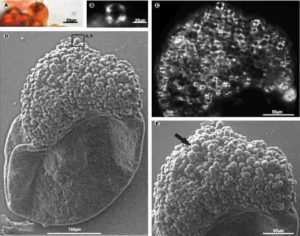
Everyone loves a nice plate of pasta. After all, starch is the ultimate energy food. Now, we have proof that carbo-loading has been a thing for at least 280 million years.
A team of Chinese and German scientists has discovered the oldest unequivocal fossilized starch ever found, in the form of granular caps on the megaspores of a Permian-age plant called a lycopsid. They also found evidence that these high energy treats may have been the power bars of early spore spreading.
“We suggest that these starch caps were used to attract and reward animals for megaspore dispersal,” explains lead author Feng Liu, of the Nanjing Institute of Geology and Palaeontology, in Nanjing, China. The study, published online ahead of print for the journal Geology, also provides early evidence for mutualism between plants and animals.
Lycopsids were vascular plants, ancestors of modern club mosses. They thrived in the teeming swamp forests of the Permian, about 280 million years ago. The fossil megaspores of lycopsids, with remarkably well-preserved starch granule toppings, were found in Permian-age coal in northern China.
Plant seeds store starch internally to nourish seedlings. But after analyzing the starch masses in the fossil megaspores using scanning electron microscopy and transmission electron microscopy, and comparing them to modern seeds, the scientists concluded that the starch caps were only outside, not inside, the megaspore. That means the starch wasn’t part of the lycopsids’ embryo nutrient system. Instead, the granules likely existed specifically as a spore-spreading device.
Ants, birds, and mammals weren’t around 280 million years ago, so the authors speculate that snails, along with arthropods like millipedes and cockroaches, may have been the main consumers of the scrumptious starch snacks. In turn, they dispersed the lycopsid megaspores. While starch certainly existed long before the Permian, this discovery dishes up new insights into its ecological role, says Feng Liu. “It can help us better understand the terrestrial animal food habit and the complexity of biotic interactions in deep geological time.” Plus, it shows that starchy food was a creature comfort long before the days of fettucine.
Reference:
Feng Liu, Benjamin Bomfleur, Huiping Peng, Quan Li, Hans Kerp, Huaicheng Zhu. 280-m.y.-old fossil starch reveals early plant–animal mutualism. Geology, 2018; DOI: 10.1130/G39929.1
Note: The above post is reprinted from materials provided by Geological Society of America.










